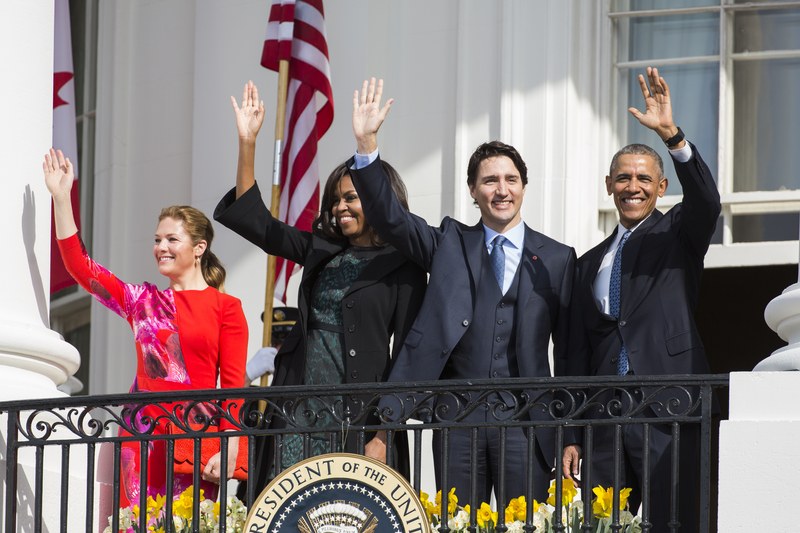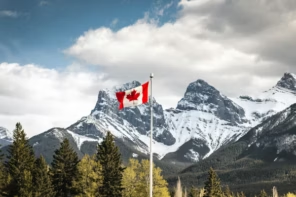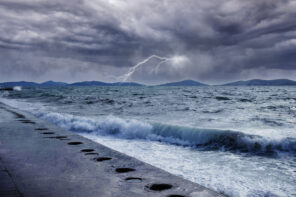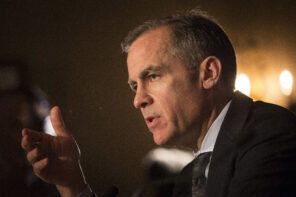By Garima Karia
Is the Trudeau-Obama “bromance” really reflective of Canada’s relationship with the United States?
The media’s newest “it-couple” is none other than Canadian Prime Minister Justin Trudeau and his American counterpart, President Barack Obama. The Canadian Prime Minister made his first official visit to the White House this March, and it seemed that news and media outlets just couldn’t stop fixating on of the two world leaders, their families, and most of all, their apparent, newfound “bromance.” However, the photographs and articles demonstrating the chemistry between these two leaders – and by association, their nations – have been carefully crafted by both leaders’ PR teams. Despite that, it seems to have generated extensive optimism on Canada-US relations.
Indeed, as the Trudeau-Obama relationship swiftly became a symbol for Canada-US relations, I asked myself whether the Trubama aesthetic accurately reflects Canada’s relationship with the United States. I sought to dig deeper by analyzing and evaluating how “bromantic” the two nations are in reality, in order to determine to what extent the Trubama relationship is in fact reflective of Canada-US relations.
Another point of contention, sheltered from mainstream media, are territorial conflicts.
While Trudeau and Obama attended State dinners and took photos for the press, Canada and the U.S. still have a number of disputed topics on the table that have yet to be resolved; the first of which is the disagreement over the Keystone XL Pipeline.
To quote David McNaughton, Canada’s new ambassador to the United States, Keystone “sucked all the oxygen out of the room in terms of the [Canada-US] relationship.” Due to the intense dichotomy that existed between the Obama administration and the Harper government’s opinions on the pipeline, McNaughton notes that so many other initiatives between the two nations “g[o]t stalled or put to the back burner” which, in turn, has “sidetracked the relationship.” After years of delaying the decision, President Obama vetoed the pipeline project in November 2015, and rejected TransCanada’s application to build the Keystone XL pipeline on environmental grounds. Former Canadian Prime Minister Harper was very much in favour of the deal, which incited lasting tension between the two countries.
This tension was amplified when TransCanada filed a NAFTA lawsuit against the United States for its rejection of the agreement; TransCanada looks to gather approximately $15 billion in the aftermath of the seven-year delay. Although he is no longer in office, Harper’s fervent support for the deal resulted in lasting tension, despite Trudeau’s recent electoral victory. With a major Canadian corporation launching a lawsuit against the US, and McNaughton left to deal with the consequences of the fall-out, US-Canada relations, at the beginning of Trudeau’s tenure, seemed less glamorous than what Trubama now makes them out to be.
While the world reveled in Trudeau’s White House visit, tensions continue to rise between Canada and US over “one of the largest and longest-running trade disputes in the world,” according to the CBC. Each year, the American market imports $10 billion worth of Canadian softwood lumber. However, as of late, these exports have been “the number one trade irritant” between Canada and the US, according to the Parliament of Canada’s website. The last trade agreement on softwood lumber between the two nations recently expired, and US lumber companies continue to be fervently opposed to the import of softwood citing the “unfair Canadian advantage,” from the Canadian lumber industry’s access to Crown-owned lands. In addition, the provincial government’s harvest prices are subsidized, as prices are administratively created rather than being determined by the market, making it more difficult for American lumber companies to compete.
This, in turn, has augmented tension between the neighbours, and the decision on whether or not to renew, and perhaps even reform, the deal weighs heavily upon McNaughton, and Canada’s new Liberal government. In the meantime, as free trade is being practiced across the border, the US Lumber Coalition fulminates on its website about “the dangers of Canadian practices left unchecked, causing unemployment or even the takeover of U.S. assets,” based on a CBC report on the issue. With domestic preferences on the line, all eyes are on Trudeau and how he will proceed in reaching a new agreement in October 2016. BC Premier Christy Clark warned that “the last time…relations around softwood lumber went sideways, [Canada’s] whole relationship with the United States went off the rails.” It seems the pressure will continue to build until a trade agreement between Canada and the United States is negotiated.
This tension was amplified when TransCanada filed a NAFTA lawsuit against the United States for its rejection of the agreement; TransCanada looks to gather approximately $15 billion in the aftermath of the seven-year delay.
Another point of contention, sheltered from mainstream media, are territorial conflicts. These conflicts continue to hinder Canada-US relations from being as optimal as ‘Trubama’ suggests. Currently, Canada and the US have six ongoing land disputes, notably over the Yukon-Alaska Dispute and the Northwest Passage Dispute. Each of these disagreements contributes its fair share to the underlying tension between the two nations.
The Yukon-Alaska Dispute is an ongoing disagreement over how to divide the Beaufort Sea. A Globe and Mail report describes it as arising from competing interpretations of an historical treaty between the United Kingdom and Russia from 1825. This contrast in interpretations has created a contention over 21,000 square kilometers: resolving the dispute has been particularly difficult because the region contains substantial oil and gas deposits, making it incredibly attractive to both governments.
Furthermore, the 1894 Western Inuvialuit Land Claim takes the Canadian position, and any border compromise with the US would mean redrawing the western most coordinates of that land claims settlement, which would be a highly politically sensitive affair. Until now, both Canada and the US have resolved to ignore it rather than address and resolve it, which has resulted in underlying tension for years.
The Northwest Passage Dispute is yet another of these land claims causing friction. While Canada asserts that some of the Northwest Passage waters, particularly those in the Canadian Arctic Archipelago, are internal to Canada, the US classifies this body of water as international, and applies a legal interpretation following that classification. A number of diplomatic incidents have subsequently occurred in the area since this debacle began over three decades ago, and both Canada and the US have declared, on separate occasions, that their militaries would consider the Northwest Passage both Canadian and international respectively, and took military and diplomatic actions accordingly.
During Trudeau’s visit to the White House, territorial disputes were far from key points on the agenda, which leaves unresolved tension between Canada and the US, though the Trubama façade seeks to sweep it under the rug.
These cases are just a few examples of the multiple issues that collectively put pressure on Canada-US relations. This multi-faceted property of the relationship, in turn, is one that is incredibly overlooked by our societies and by the media. In order to fully understand international relations, it is important to acknowledge that the Canada-US relationship is far from perfect. We must recognize that the ‘Trubama bromance’ has a long list of issues, behind the glamorous White House photo ops and Stanley Cup-referencing speeches, that it must address.
To end on an optimistic note, despite the existence of tensions relating to the pipeline, trade disagreements and territorial disputes, I do think that Trudeau’s first visit to The White House, and the Trubama relationship as a whole, have demonstrated real potential for growth and decisive action to relieve some of the lasting tension between Canada and the US. During Trudeau’s first visit to the White House alone, the two leaders announced a joint climate change initiative that includes a new science partnership on the Arctic and firm numbers for methane emissions reductions, setting an objective of reducing them by 40-45% below 2012 levels by the year 2025, among other efforts and displays of common ground between the two nations.
Hopefully, through ‘Trubama’s’ partnership as leaders on the world stage, these two nations must address and resolve some of the key issues between them, for their countries and for continuing to work towards a better future at home and abroad.








